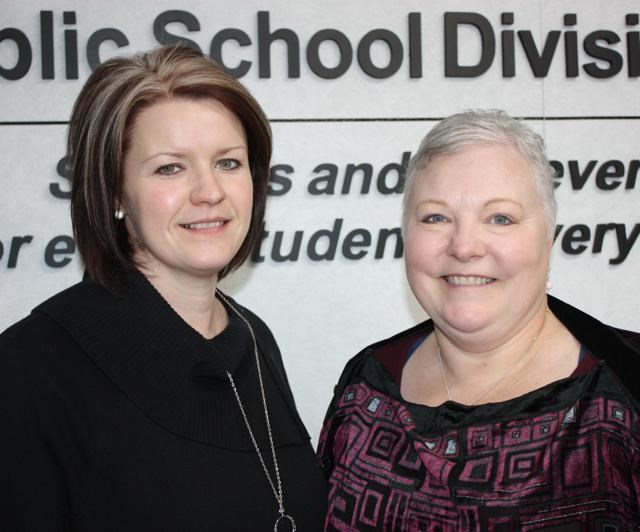By Norm Park, contracted reporter
The team Cheryl Anderson and Tracey Kiliwnik (shown in the photo above) brought interesting facts, figures and plans to the board members attending the monthly meeting of the South East Cornerstone School Division.
Kiliwnik, the co-ordinator of learning supports and Anderson, co-ordinator of student services, spoke to the board members for about a half hour. They delivered data-driven information regarding programs designed for students with intensive needs and those with diagnosed problems that could be addressed in various ways by the division while delivering traditional academic lessons.
Kiliwnik spoke about students who required the assistance of learning support teachers, those with complex medical issues, while others with behavioural or complex medical and behavioural support needs also required specific attention. She said there are 174 students identified as requiring one or more learning support services within the division’s student population of around 8,300.
The number of students who need intensive supports are 78 needing learning support teachers, 44 who have complex medical needs, 11 with complex behavioural needs, and 22 with complex medical and behavioural needs.
The number of students with autism has increased, she noted but earlier diagnosis from health professionals is helping ease the pressure on the educators, she said.
The gap is also closing for students ages six to 18 who are engaged in the Jordan’s Principle program that supports families and encourages them to connect with qualified service providers within First Nations communities. There are 22 students currently being facilitated within and beyond those centres.
Kiliwnik said with two occupational therapists now employed by the division, “they are covering more ground and teacher awareness is growing. They are asking us the questions such as, ‘I see a student with needs, where do I go next?’”
Anderson focused the first part of her segment on English as Another Language where 523 Cornerstone students are registered for additional assistance. That is an increase from the 482 they had the previous school year, but she stated, over the past few years, the EAL numbers have remained relatively stable at around 500.
Anderson said once the student reaches a B2 level on the support scale, they are capable of maintaining a learning pace on par with other students. “We build new resources and put more supports in place where we have identified the needs,” she said. That includes the use of literacy coaches, as one example where an EAL program or student can get a boost.
Responding to an inquiry from trustee Elwood White, regarding the number of different languages being spoken by incoming EAL students, Anderson said there are currently 47 languages being spoken by EAL students.
The topic then moved to behaviour incidents, use of educational psychologists and documentation. She said the number of incidents remains fairly static and the students’ wellbeing and health can be tracked and monitored.
Board chairwoman Audrey Trombley noted some numbers were veering upward, but she said that was probably due to the fact that assistance programs were being used more.
Behaviour tracking plans and the use of the Southeast Regional Hub for discussions and action plans that include mental health and addictions services, social services, police services and justice systems as well as the Holy Family and Cornerstone school division professionals, has improved the services substantially since its inception in the 2013-14 school year, Anderson added.
Other factors such as students with attendance issues, is also being addressed and those numbers are improving she said with 16 full time equivalent counsellors available.
Incidents involving suicidal thoughts (86) and attempts (20 in the past year) were recorded with the notation that outside agency involvement was implemented 31 times.
Teachers have a host of support materials, tools and processes now at their disposal, said Anderson. That, she said, helps them significantly.
“Students are engaged and teachers are saying they are feeling better about broaching subjects,” Anderson said. Positive mental health mind frames are now witnessed with Gay Straight Alliance (GSA) committees currently established in 28 of the division’s 38 schools accommodating 19 GSA groups, as an example.



